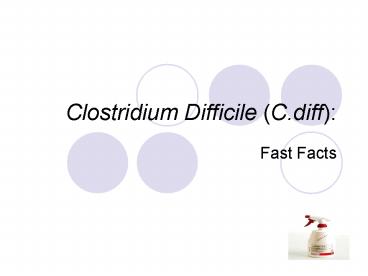Clostridium Difficile C'diff: - PowerPoint PPT Presentation
1 / 18
Title:
Clostridium Difficile C'diff:
Description:
C. diff is a bacteria that lives in the intestinal tract of about 5% of healthy adults ... CDAD is sometimes called antibiotic ... How is C. diff transmitted? ... – PowerPoint PPT presentation
Number of Views:167
Avg rating:3.0/5.0
Title: Clostridium Difficile C'diff:
1
Clostridium Difficile (C.diff)
- Fast Facts
2
What is Clostridium difficile (C. diff)?
- C. diff is a bacteria that lives in the
intestinal tract of about 5 of healthy adults - C.diff-associated disease (CDAD) occurs when the
normal intestinal flora is altered which allows
the bacteria to grow and produce disease causing
toxin. CDAD is sometimes called antibiotic
associated diarrhea
3
What are the main clinical symptoms of CDAD?
- Common symptoms include watery diarrhea
(sometimes with blood or pus), fever, loss of
appetite, nausea, and abdominal pain. - Complications can include pseudomembranous
colitis, toxic megacolon, perforations of the
colon, sepsis, and sometimes death.
4
How is C. diff transmitted?
- C. diff is shed in feces and can contaminate high
contact surfaces such commodes, thermometers,
bed-side tables, etc. - C.diff is often spread to patients on the hands
of health care workers or other people who touch
a contaminated surface.
5
(No Transcript)
6
Who gets CDAD?
- Anyone taking antibiotics very few people who
are not on antibiotics get CDAD - Persons with inflammatory bowel diseases
- Persons who have had gastrointestinal surgery
- Persons on chemotherapy
7
Diagnosis and Treatment
- Residents with diarrhea should have a stool
specimen tested for C.diff. Testing is not
recommended for people with no symptoms (i.e.
screening or test for cure) - DO NOT USE ANTI-DIARRHEALS
- Treatment
- Stop antibiotics, if possible (23 of cases
resolve in 2-3 days) - If diarrhea continues, try Flagyl or Vancomycin
8
Why all the recent attention?
- Reports of CDAD disease have increased, noting
more severe disease and an associated increase in
mortality. - The increased rates and/or severity of disease
may be caused by changes in antibiotic use,
changes in infection control practices, or the
emergence of a new strain of C.
difficile-associated disease with increased
virulence and/or antimicrobial resistance.
9
How can CDAD be prevented in our facility?
- Use antibiotics judiciously
- Use Contact Precautions for patients with CDAD
- If possible, place these patients in private
rooms or place in rooms (cohorted) with other
patients with C. difficile-associated disease. - Use gloves when entering patients rooms and
during patient care. - Use gowns if soiling of clothes is likely.
- Dedicate equipment whenever possible. If not
possible, disinfect equipment between patients. - Precautions should be continued until diarrhea
has ceased. - Wash hands with SOAP and WATER before and after
caring for patients.
10
How can CDAD be prevented in our facility
(cont.)?
- Implement an environmental cleaning and
disinfection strategy - Use an Environmental Protection Agency
(EPA)-registered hypochlorite-based disinfectant
for environmental surface disinfection after
cleaning in accordance with label instructions
generic sources of hypochlorite (e.g., household
chlorine bleach) also may be appropriately
diluted and used. (Note alcohol-based
disinfectants are not effective against C.
difficile and should not be used to disinfect
environmental surfaces.)
11
A Word on Reporting
- Facility based reporting January 1, 2006-
December 31, 2006 - Case Definitions
- Health Care-Associated (Initial) Positive
laboratory diagnostic test, endoscopy or biopsy
gt48 hours after admission to a health care
facility. - Health Care-Associated (Recurrent) Subsequent
positive laboratory diagnostic test, endoscopy or
biopsy in an individual with a previous health
care-associated positive within the prior 6
months. A subsequent infection which occurs gt6
months after an initial infection is also
classified as an initial infection.
12
Reporting (cont.)
- Patient Days Reporting
- Reported monthly
- Total Patient Days Sum of the daily census over
the entire month - Ex. 12 on the 1st 12 on the 2nd 13 on the
31st Total Patient Days for the Month
13
Further Recommendations
- Form an Infection Control Committee
- Post signs reminding staff, visitors, and
residents to wash their hands - Provide inservices for staff on infectious
disease and control measures
14
Reportable Infectious Diseases in Ohio
- Refer to the list of reportable diseases and the
Northeast Ohio Communicable Disease Report form
in your packet. - Cuyahoga Central Disease Reporting
- phone 216-201-2080
- fax 216-676-1316
15
Educational Resources
- ODH will be offering infection control courses
through APIC (EPI 101 EPI 201) - Courses will take place in Toledo, Columbus, and
Cambridge - Go to www.apic.org for course descriptions
- Dates and times will be sent out later
16
Hospital C.diff Rateswww.odh.state.oh.us
- Initial Rate (cases per 10,000)
- Jan - 8
- Feb - 8
- Mar - 7
- Apr - 8
- May 8
- June 7
- Recurrent Rate (cases per 10,000)
- Jan - 2
- Feb - 2
- Mar - 2
- Apr - 2
- May 2
- June - 2
17
Add Safe Environment Info
18
Thank you for your time and attention.
- www.ccbh.net
- 216.201.2020 (option 2)































